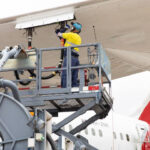Two new reports have highlighted the considerable costs and logistics of transitioning air transport to novel propulsion aircraft, both emphasising the need for urgent action to enable the switch. A report by the World Economic Forum (WEF) as part of its Target True Zero initiative indicates that by 2050, the aviation industry will need to invest between $700 billion and $1.7 trillion to provide sufficient infrastructure for hydrogen, battery-electric and hybrid-electric aircraft. It argues the foundation elements must be in place by 2025 and says new partnerships are essential between the aviation sector and energy suppliers. A parallel report by European advocacy group Transport & Environment (T&E) says hydrogen-powered aircraft will cost 8% more to operate than fossil-fuelled planes but could be 2% cheaper from 2035 if their development is supported by government incentives, funded through taxes on conventional jet fuel and a price on carbon. “These pricing measures are key to the deployment of green technologies like hydrogen planes,” says T&E.
The WEF report was produced with the support of McKinsey and Partners, the Aviation Environment Federation and the Aviation Impact Accelerator of the University of Cambridge to help quantify challenges involved in the transition to new propulsion technologies. It estimates that by 2050, battery-electric and hydrogen-powered aircraft could comprise between 21% and 38% of total fleets, and require 15% to 34% of the industry’s total energy needs.
Of this power, says WEF, between 89% and 96% would be needed for hydrogen-powered aircraft, with the remaining 4% to 11% for battery-electric turboprops, regional jets and small narrowbody planes. The introduction of hydrogen and electric propulsion would also require separate infrastructure value chains and necessitate production of power away from airports, which would not have sufficient land for the energy infrastructure. “The investments needed to meet 2050 alternative-propulsion-related infrastructure goals must start now,” stresses the report, with the first elements required to be in place by 2025.
“Getting infrastructure right will be critical in allowing this new industry to take off – whether that means ‘on-airport’ infrastructure, such as chargers and refuellers, or ‘off-airport’ infrastructure, such as producing enough green electricity,” write McKinsey Partner Robin Riedel and WEF Climate Head Pedro Gomez in their foreword to the report. “There is a great deal at stake in getting this transition right. Collaboration across geographies, industries and stakeholders is critical to fast-track aviation’s trajectory towards a more sustainable future.”
The sheer volume of energy needed to power the emerging generation of novel propulsion aircraft is identified by WEF as a key challenge in the transition to zero-emission commercial flights. Globally by 2050, it estimates alternative propulsion systems could need between 600 and 1,700 terrawatt hours of clean energy, “which is equivalent to the energy generated by around 10 to 25 of the world’s largest wind farms, or a solar farm the size of Belgium.”
As well, to power alternative propulsion aircraft, the WEF report says airports will need to massively increase their on-site energy use, with battery-electric and hydrogen-powered fleets each needing their own energy infrastructure. “For an airport that is a large hub looking to invest in on-site hydrogen liquefaction and charging for battery-electric powered aircraft, total on-site electricity consumption for terminals, ground support and other uses could be between 1,250 and 2,450 gigawatt hours per year, which is about five to 10 times more electricity than London Heathrow currently consumes.”
Producing new power would also present a major challenge, for while most airports would have room to develop hydrogen liquefaction and storage infrastructure, they would have nowhere near enough land for infrastructure to generate the clean energy required to power battery-electric or hydrogen aircraft.
“While airports have been touted as possible energy hubs, the scale of energy demand for alternative propulsion will make it extremely difficult to perform all energy production at airports,” says the report. “If Paris Charles De Gaulle Airport is used as an example of a major international hub, it would require approximately 5,800 hectares of solar panels to generate sufficient electricity to meet its demands under the Mission Possible Partnership’s prudent scenario. This far exceeds the size of the airport itself, which now occupies 3,300 hectares.”
The report says transition to novel propulsion aircraft would require capital investment of between $700 billion and $1.7 trillion by 2050, around 90% of which would be for off-airport infrastructure, mainly to generate power and for hydrogen electrolysis and liquefaction. On-airport infrastructure, which comprises the remaining 10%, will total “a more modest” $66 billion to $114 billion by 2050.
“Capital expenditures in green power generation for aviation alone would double the current projections for global airport capital infrastructures, $1.68 trillion by 2040 at $84 billion per year,” it calculates. “This makes it almost certain that aviation players will need to form partnerships with companies in other industries, such as energy providers and those in hydrogen-consuming industries, to secure the required investment.
“The investments needed to meet 2050 alternative-propulsion-related infrastructure goals must start now. The first elements of on-airport infrastructure must be in place by 2025 to meet the expected energy demand.”
The report’s authors also say operators of alternative propulsion should expect to pay between 76% and 86% more than the market price for renewable electricity, pricing which reflects additional costs of operating aviation infrastructure.
The report commissioned by Transport & Environment, and produced by research group Steer, concludes hydrogen-powered jets could be operated less expensively than fossil fuel-powered aircraft from 2035 “provided kerosene is taxed adequately”.
It says: “In 2035, running planes on hydrogen could be 8% more expensive than using kerosene. But with a tax on fossil jet fuel and a price on carbon, hydrogen planes could become 2% cheaper to operate than their kerosene counterparts. These pricing measures are key to the deployment of green technologies like hydrogen planes.”
The T&E analysis shows that by 2050, deployment of hydrogen aircraft for intra-Europe flights would cost €299 billion ($320bn), of which only 5% (€15 billion) would be for the development of hydrogen planes. “This relatively small upfront cost must, however, happen before 2035, or risk jeopardising the success of these new planes.”
The balance of the cost would be outside the aviation sector, with green hydrogen production accounting for €161 billion, or 54%, then hydrogen liquefaction at 23%, hydrogen infrastructure at airports (12%) and distribution of the fuel to airports (6%).
T&E highlights the commitment by Airbus to launch hydrogen-powered aircraft by 2035, but said the airframer had since warned of delays due to slow development of hydrogen infrastructure.
“Building these planes is feasible,” said T&E’s aviation technical manager Carlos Lopez de la Osa, “but if we want Airbus to walk the talk, we’ll need to create a market for zero emission aircraft by taxing fossil jet fuel and mandating zero emission planes in the future. “For hydrogen planes to take off in the next decade, we need to enter the virtuous circle of regulation, investment and a fall in prices, followed by stronger uptake. But the cost must be shouldered by the aviation industry and its users by ring-fencing part of carbon and kerosene tax revenues for green tech like zero emission planes and clean fuels.”
Image: The Airbus ZEROe concept hydrogen-powered aircraft














More News & Features
Aviation needs better measurement to deliver meaningful decarbonisation
More targeted and faster measures needed to overcome barriers and unlock SAF’s full potential, finds PA study
NATS survey shows a continuing disconnect of public attitudes to the environmental impact of flying
Aviation and fuel industries call for urgent EU policy action on SAF deployment
ZeroAvia intensifies UK activity, as it progresses certification of zero emission powertrains
KLM and Transavia partner with Elysian to develop battery-electric regional aircraft and ecosystems